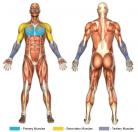Bent-Forward Crossovers (Cable)
Performance Description
- Attach the single-grip cable attachments to both sides of a dual pulley, and ensure that they are set in a low position (i.e. at floor-level).
- Grasp the attachments, stand with your legs about shoulder width apart or less, and lean forward slightly. Note: Whether your legs are side by side or one in front of the other is a matter of preference.
- Move your arms upward and inward (being sure to keep, at minimum, a slight bend in the arms at all times) until either your knuckles meet one another or your arms cross at the wrists (whichever you prefer), while exhaling throughout the movement. Note: Once at the peak of the positive aspect of the movement (i.e. when your knuckles have met or you have crossed your arms), isometrically contract your pectorals to achieve optimal sternal head contraction. It is recommended that the hand on top is alternated each repetition (i.e. left, right, left, right, etc.) for most identical muscular recruitment of each pectoral muscle to be achieved.
- Lower your arms in a controlled manner until they are at your sides, inhaling throughout the movement.
- Repeat steps 3-4 for as many repetitions as are desired.
Primary Muscle(s)
Chest (Pectoralis Major)
Chest (Pectoralis Major: Lower Aspect)
Chest (Pectoralis Major: Sternal 'Inner' Head)
Secondary Muscle(s)
Biceps (Biceps Brachii: Short 'Inner' Head)
Biceps (Coracobrachialis)
Shoulders (Deltoid: Anterior)
Tertiary Muscle(s)
Forearms (Brachioradialis)
Forearms (Flexor: Carpi Radialis)
Forearms (Flexor: Carpi Ulnaris)
Forearms (Flexor: Digitorum Superficialis)
Forearms (Palmaris Longus)
Forearms (Pronator Teres)
Further Clarification
As noted above, the crossed-arm motion is where the inner chest (sternal head) is most optimally contracted. If the goal is to work the inner aspect of the chest, then pay extra attention to the squeeze at the very end of the positive motion (i.e. where the knuckles have met or arms have crossed).
Bent-forward crossovers work the lower aspect of the pectorals and the inner (sternal head) of the pectorals quite well, and are relatively safe for a flying motion.
Things To Look Out For
Biceps injuries, though uncommon, can occur with flys. As a general rule, if not familiar with flys or if pain is felt, use good judgment and only use weight amounts that you are comfortable with.
Level
Beginner
Exercise Position(s)
Standing
Exercise Variations
Considered An Exercise In The Following Categories





